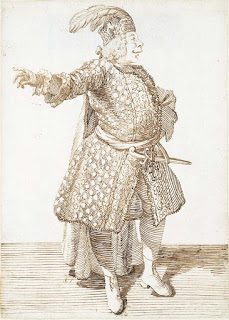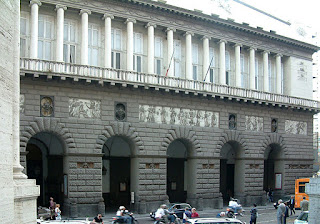Court choirmaster wrote several important operas
 |
| Domenico Sarro, as depicted by Nicolò Maria Rossi |
He was given the middle name, Natale, which is the Italian word for Christmas.
Sarro is famous for being the composer of Achille in Sciro, the opera chosen for the opening night of the new Teatro San Carlo in Naples in 1737.
He studied music from the age of six at Sant’Onofrio, a church near Porta Capuana, one of the ancient city gates of Naples, which at the time was the location of the city’s music conservatory. His first opera, L’opera d’amore, was performed in Naples in 1702.
He was appointed assistant choirmaster to the Neapolitan court in 1702 and by 1706 was having his religious music performed in churches in Naples. He wrote several of what were then referred to as three-act musical dramas, which were performed in theatres and private palaces throughout the city.
Sarro’s opera, Didone abbandonata, was premiered on February 1, 1724 at the Teatro San Bartolomeo in Naples. It was the first setting of a major libretto by the writer Pietro Metastasio, who would become the most celebrated librettist of the 18th century. The intermezzo, Dorina e Nibbio or L’impresario delle canarie, has been performed extensively by orchestras since then, right up to the present day. It has also been imitated by composers such as Tomaso Albinoni, Francesco Gasparini, Leonardo Leo and Martini il Tedesco.
 |
| The title page of Sarro's opera Didone Abbandonata |
Sarro, sometimes called Sarri, also wrote many vocal cantatas, which have been admired by music experts for their charm and inventiveness.
The only known portrait of Domenico Sarro is part of a painting called The Viceroy at the Festa of the Quattro Altari by Nicolò Maria Rossi. Sarro is one of the many composers depicted by the artist as part of the Neapolitan Court.
Domenico Sarro died in Naples in 1744, aged 65.
| Trani's 12th century duomo - the Cattedrale di San Nicola Pellegrino - stands on a platform on the sea |
The port of Trani, where Domenico Sarro was born, is about 40km (25 miles) to the northwest of Bari. It was a flourishing port as early as the 11th century because of its location on the Adriatic Sea. In 1063 Trani issued a maritime law code, believed now to be the oldest in western Europe. Trani has lost its old walls and bastions but still has a 13th century fort, which has been restored as a museum and performance venue. The 12th century Cathedral on a raised site over the sea is dedicated to St Nicholas the pilgrim, a Greek who died there in 1094 while on the way to Rome.
Search tripadvisor for a hotel in Trani
| The church of San Pietro a Majella, looking along Via dei Tribunali |
Sarro studied at the Music Conservatory when it was in Sant’Onofrio in Naples. Today, the Music Conservatory is in the complex of San Pietro a Majella, close to Via dei Tribunali, one of the main thoroughfares in the heart of the centro storico in Naples. It is the last of a string of establishments that were once music conservatories in Naples, dating back to when the Spanish ruled the city in the 16th century. One of the earliest, I Poveri di Gesù Cristo, was founded in 1589 by Marcello Fossataro, a Franciscan monk. It was next to the Church of Santa Maria a Colonna on Via dei Tribunale, but in 1743 it was converted into a church seminary.
More reading:
Tomaso Albinoni, the Venetian most famous for his haunting Adagio in G Minor
How Pietro Metastasio progressed from street entertainer to great librettist
Francesco Gasparini, the musical director who gave Vivaldi a job
Also on this day:
Vigilia di Natale - Christmas Eve
1836: The birth of food canning pioneer Francesco Cirio
1897: The birth of Lazzaro Ponticelli, the longest surviving veteran of World War One
Home



